

Angels' Flight
Los Angeles

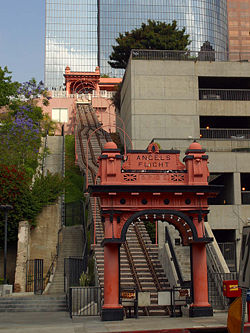
| On Grand Opening day, New Year's Eve 1901, passengers
got a free ride and a dollop of fruit punch. The Third & Hill Street
landmark was dismantled in the spring of 1969. [1]
Angel's Flight (open 6 a.m. to 12:15 a.m., round trip fare 5¢) at 3rd and Hill St is a funicular railway transporting passengers 315 feet up and down the steep slope of Bunker Hill between Hill and Olive Streets. During the 1920's it carried as high as 12,000 passengers a day. [2] |

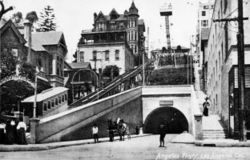
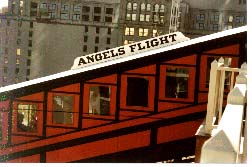


| Angels Flight is a landmark funicular railway
[3] in the Bunker
Hill district of downtown Los Angeles, California, which claims to be the
"shortest railway in the world". But shorter ones are contained in the
item below listing other funiculars - notably the three in Bournemouth, England.
The funicular has operated on two slightly different sites, using the same cars.
The first Angels Flight operated from 1901 until it was closed in 1969 when its
location was redeveloped.
After 27 years in storage, the funicular was rebuilt and reopened in 1996 a half block south of the original site. Although the original cars were used, a brand new track and haulage system was designed and built, a redesign which had unfortunate consequences five years later. As rebuilt, the funicular was 91 meters (298 feet) long on an approximately 33-percent grade. Car movement was controlled by an operator inside the upper station house, who was responsible for: visually determining that the track and vehicles were clear for movement, closing the platform gates, starting the cars moving, monitoring the operation of the funicular cars, observing car stops at both stations, and collecting fares from passengers. The cars themselves did not carry any staff members. Angels Flight was added to the National Register of Historic Places on October 13, 2000. [4] |
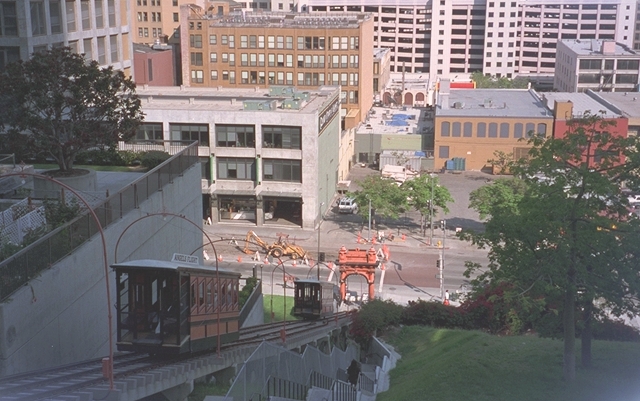

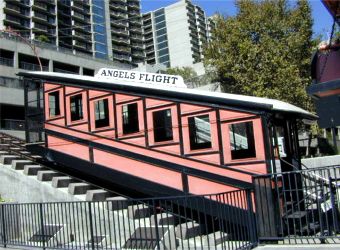

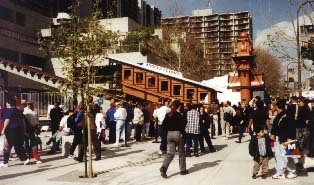
| On February 1, 2001, Angels Flight suffered a
serious accident that killed passenger Leon Praport, 83, and injured seven
others, including Praport's wife, Lola. The accident occurred when car Sinai,
approaching the upper station, reversed direction and accelerated downhill in an
uncontrolled fashion to strike Olivet near the lower terminus.
The Angels Flight funicular in Los Angeles employs the three-rail configuration. Originally designed and constructed using a single cable attached at each end to the cars until its removal in 1969, Angels Flight was reinstalled using separate cables for each car powered from a geared mechanism. It was in fact this new mechanism which failed and caused the only accident in the railway's history.
More fabulous photos of this landmark in the 1900's http://www.ulwaf.com/LA-1900s/PicturePages/AngelsFlight3rdSt.html |
|
1] El Pueblo Grande by John D. Weaver, printed privately page 73. [2] (Los Angeles, A guide to the City and its Environs; compiled by the Workers and Writers Program of the Works Project Administration in Southern California published 1941 [3] The basic principle of funicular operation is that two cars are attached to each other by a cable, which runs through a pulley at the top of the incline. Counterbalancing of the two cars, with one ascending and one descending the slope — especially when transporting similar loads, such as passengers — minimizes the energy needed to lift the ascending car. [4] http://en.wikipedia.org/wiki/Angels_Flight
|